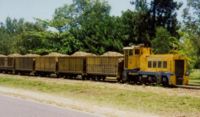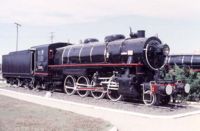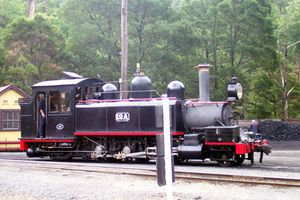Narrow gauge railways of Australia
Prior to Australia becoming an independent unified country in 1901, each of the six British colonies in Australia were responsible for rail transport infrastructure. Of the six colonies, only three (Queensland, Western Australia, and Tasmania) opted for narrow gauge railways. The other colonies (later states) opted for either standard gauge or broad gauge railways, maintaining only limited narrow gauge rail lines, except for South Australia, which wavered between narrow and broad. As a result of this legacy, Australian railways are a confusing mix of all three gauges. Over time most of the mainland lines of whatever gauge linked up with inconvenient break-of-gauge stations where they met, including the infamous Albury railway station on the Albury-Wodonga line from Melbourne to Sydney where the old cry of "Albury, all change!" has sunk into the national psyche. Some lines remained isolated because they were cut off by long stretches of desert.
Contents
Queensland
The massive narrow-gauge 3 ft 6 in (1067 mm) coal trains of the Queensland Railway with 100 wagons and 2 midtrain electric locomotives show what is possible with narrow gauge with modern equipment and tracklaying techniques. South African railways run similar heavy trains.
In 1865, the brief given to Queensland Railways was to build a semi-mountainous line in very sparsely populated territory, and it chose light rails, sharp curves, a small loading-gauge, light engines and rolling stock, 32 km/h speeds to make a limited budget go a long way. A clever salesman convinced the Queensland government that a narrow gauge would save money, and do the job for a hundred years. Queensland Railways was the first mainline narrow-gauge railway in the world [citation needed]. Its tracks would eventually extend to around 9000 km.
In the intervening century, the rails have been replaced with heavier rails, there are now concrete sleepers and colour light signals, sharp curves have been straightened, tunnels have been opened out. The one thing that hasn't changed is the narrow gauge, even though the rest of the country is converting its main lines to the standard gauge 1,435 mm (4 ft 8½ in).
Queensland Rail also operates the iconic QR Tilt Train, with a maximum speed of 165 km/h, this train currently holds the Australian Railway Speed Record of 210.7km/h.
Dual gauge has been added to give access from the interstate standard gauge line to the Port of Brisbane. Dual gauge is also proposed to convert the standard gauge interstate line for use by narrow gauge commuter trains.

Queensland also has extensive sugar cane tramways of 2 ft (610 mm) gauge. These cane tramways sometimes use second hand standard-gauge shunting locomotives suitably regauged. The cane trams regularly haul over 500 tonnes of raw cane at a time, and because there are no continuous brakes, they may have a radio-controlled brake van coupled to the rear.
To avoid speed restriction where some cane trams cross the main line, several of these crossings have been converted to drawbridges.
Tasmania
The first railway in the island state of Tasmania was broad gauge 5 ft 3 in (1600 mm), but following the success of the narrow gauge in Queensland, a third rail was fitted, to allow conversion to narrow gauge. The state's rail network is now entirely narrow gauge.
South Australia
The first railways in this state were broad gauge (5 ft 3 in, 1600 mm) including some light-weight horse-drawn lines. But following the success of the narrow gauge in Queensland, several narrow-gauge lines where started. Because of the geography of the state with deep gulfs of the ocean, the various narrow-gauge lines where isolated from each other to begin with. In the 1920s several narrow-gauge lines were converted to broad gauge.
The South Eastern narrow-gauge lines were converted to broad gauge in the 1950s, with steel sleepers able to be converted to standard gauge at a later date if required.
The privately owned iron ore mines at Iron Knob and Iron Baron are connected to the steel works at Whyalla by an isolated narrow gauge 3 ft 6 in (1067 mm) line through desert country.
Western Australia
Inspired by the success of the narrow gauge in Queensland, Western Australia adopted the same gauge.
In the capital of Perth, there was the only narrow gauge tramway network (of any considerable extent) on mainland Australia. The final portion was closed in 1958.
Northern Territory
The Northern Territory adopted narrow gauge when it was still part of South Australia, and a North-South transcontinental line was planned from Adelaide to Darwin in the 1870s. In the event this line was never completed, and due to flood damage and lack of traffic, the narrow-gauge line was closed. A 3000 km standard-gauge line from Adelaide to Darwin, referred to as the Ghan, opened in 2004.
Because there are no tunnels or narrow bridges on the old-narrow gauge line, the line received a lot of second-hand standard-gauge rolling stock, this rolling stock being noticeably larger than the original narrow gauge waggons and carriages.
New South Wales
The large silver-lead mine at Broken Hill is only 30 km from the South Australian border, but separated by hundreds of kilometres of desert from the main NSW standard-gauge railway system. These mines are connected by a narrow-gauge railway.
On the main lines radiating from the state capital Sydney, ever increasing traffic required heavier engines, and therefore heavier track and stronger bridges.
In NSW in 2004, there are now about 10 classes of track from 1 to 5. All engines and rolling stock can operate on the heaviest class 1 track, while only certain light locomotives and rolling stock can operate at low speeds on class 5 track. The track classes are a kind of break-of-gauge that permits through running with careful attention to detail.
Victoria
Most railway lines in Victoria were built to the 5 ft 3 in (1600 mm) broad gauge. However four common carrier lines were built to the 2 ft 6 in (762 mm) narrow-gauge standard, to serve local farming and forestry communities. There was also widespread usage of narrow-gauge forestry railways and tramways. Sections of two lines (Belgrave to Gembrook and Thomson to Walhalla) have been restored as tourist railways.
The Puffing Billy Tourist Railway is maintained and operated by volunteers as a steam-hauled preserved railway and tourist attraction. The last of the four narrow-gauge railways to open, the Moe to Walhalla line in Gippsland which was opened in 1910 and then closed in 1954, has been partially reopened from Thomson Station into Walhalla in recent years as the Walhalla Goldfields Railway. Because the Puffing Billy Railway has nearly all of the remaining locomotives and rolling stock known to exist from the four NG lines, this line has had to modify rolling stock from elsewhere or build new, but non-original style, rolling stock.


